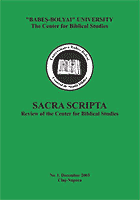Pre-figurative Ancient-Testament Types for the New Testament Ecclesiology
Pre-figurative Ancient-Testament Types for the New Testament Ecclesiology
Author(s): Ioan ChirilăSubject(s): Christian Theology and Religion
Published by: Universitatea Babes-Bolyai - Centrul de Studii Biblice
Summary/Abstract: The relationship between the two testaments is often defined using the type-antitype binom, a definition that may introduce a dichotomy which is dangerous for Christian understanding and life, a dichotomy which may push to antinomy, antithesis and tension. Or, the Scriptures are not a book of antinomies, antitheses and tensions, even if it claims you to the world of perfection energies through all which it has. The Scriptures are an organic whole, and that is due only to the uniqueness of the Whole from which it grows away in a dynamic verb, a dynamism reflecting His everlastingness. If we want to step out of the common expressions of the discourse launched by the religions morphologies, out of the sphere of the type-antitype binom, we must introduce in the discourse, in its primary morpho-logosical forms, the binom enounced above. And that’s why. In the discourse of religions morphologies, the movement is consumed in the direction of history’s vector (as a sum of persons, acts and events), changing the normal direction of the new. That which is in fact new, the primitive creation, becomes arche – old, and that which is new, as a gift of God, recapitulative of the illo tempore, becomes the only new, i.e. the type. Or, the authentic movement is the one which makes the history vector become transcendent, i.e. the type created as a dynamic reality grows always synergistically to the ante-type, to its eternal paradigm. The profound mutation of the ecclesiologic pre-figurative discourse is realized in Jesus Christ, the One who recapitulates in Himself in a restorative way the whole creation and offers it the possibility to be circumscribed in His ecclesial thelos by the grace of His Cross. Hosea had seen this and that’s why he never talked about the temple or Jerusalem as the center, but he talked about the Jerusalem of our heart in which we, in an ascetic way, even those from the conjugal union, are opened to the restoration as living limbs of Christ’s mystical body. That is why we must say to our time that through the human person he must develop into an ecclesial time, a time of salvation. We must walk through the Creation as through the Church of God’s Glorification.
Journal: Sacra Scripta
- Issue Year: II/2004
- Issue No: 1
- Page Range: 9-26
- Page Count: 18
- Language: English
- Content File-PDF

